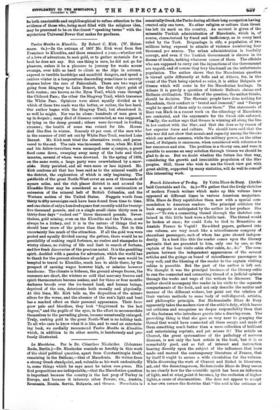Twelve Months in Klondike. By Robert C. Kirk. (W. Heine-
mann. 6s.)—In the autumn of 1897 Mr. Kirk went from San Francisco to Klondike, and there remained a year,—whether out of a love of adventure, to seek gold, or to gather materials for a book he does not say. But one thing is sure, he did not go for pleasure, unless it be a pleasure to journey for weeks across swamps, over hills as hard to climb as the Alps in autumn, exposed to terrible hardships and manifold dangers, and spend a sunless winter in a temperature descending sometimes to seventy degrees below the zero of Fahrenheit. There are two ways of going from Skagway to Lake Bennet, the first object point of both routes ; one known as the Dyers Trail, which runs through the Chilcoot Pass ; the other the Skagway Trail, which traverses the White Pass. Opinions were about equally divided as to which of these two roads was the better, or rather, the less hard. Our author began with the Skagway Trail, but abandoned it, as well he might. Nor was he alone : hundreds of men gave it up in despair ; many died of diseases contracted, as was supposed, by lying on the damp ground ; others were drowned in fording streams ; the health of some was ruined for life. Horses died like flies in winter. Scarcely 10 per cent. of the men who in the summer of 1897 set out by White Pass Trail, reached Lake Bennet. Mr. Kirk next tried the alternative route, and perse- vered to the end. The rain was incessant. Once, when Mr. Kirk and his fellow-travellers were encamped near al canyon, a great flood came down, sweeping away many of the huts and their inmates, several of whom were drowned. In the spring of 1898, on the same route, a large party were overwhelmed by a snow- slide. Sixty perished, and all were more or less injured. Mr. Kirk confirms all that has been said as to the mineral wealth of the district, the exploration of which is only beginning. The goldfields of the great North-West cover an area of thousands of square miles, and the rich placer district in and around the Klondike River may be considered as a mere continuation or extension of the mineral belt of British Columbia, and the Western section of the United States. Nuggets worth from thirty to fifty sovereigns each have been found from time to time, and one claim of only a hundred square feet recently sold for twenty- five thousand pounds, and cn a single small claim thirty men in thirty-four days "rocked out" three thousand pounds. Never- theless, gold mining, even on the Klondike and the Yukon, must always be a lottery, and it is in the nature of things that we should hear more of the prizes than the blanks. But in this uncertainty lies much of the attraction. If all the gold won were pooled and equally divided among the getters, there would be no possibility of making rapid fortunes, no rushes and stampedes to wintry climes, no risking of life and limb in search of fortune, and few fresh discoveries of the precious metal. It is the gambling spirit, doubled with a passion for adventure, which the world has to thank for the present abundance of gold. Few men would be tempted to travel to Klondike, much less to abide there, by the prospect of earning wages however high, or salaries however handsome. The climate is hideous, the ground always frozen, the summers are short, the winters so cold that mercury freezes and spirit thermometers become useless, and for three or four months darkness broods over the ice-bound land, and human beings, deprived of the sun, deteriorate both morally and physically. At this time, Mr. Kirk tells us, the disposition of the miners alters for the worse, and the absence of the sun's light and heat has a marked effect on their personal appearance. Their faces grow pale and bloodless, they look "frightened to the last degree," and the pupils of the eyes, in the effort to accommodate themselves to the pervading gloom, became unnaturally enlarged. Truly, seeking gold in the great North-West is no holiday task. To all who care to know what it is like, and to read an entertain. ing book, we cordially recommend Twelve Months in Klondike, which, in addition to its other merits, is handsomely and pro- fusely illustrated.






















































 Previous page
Previous page